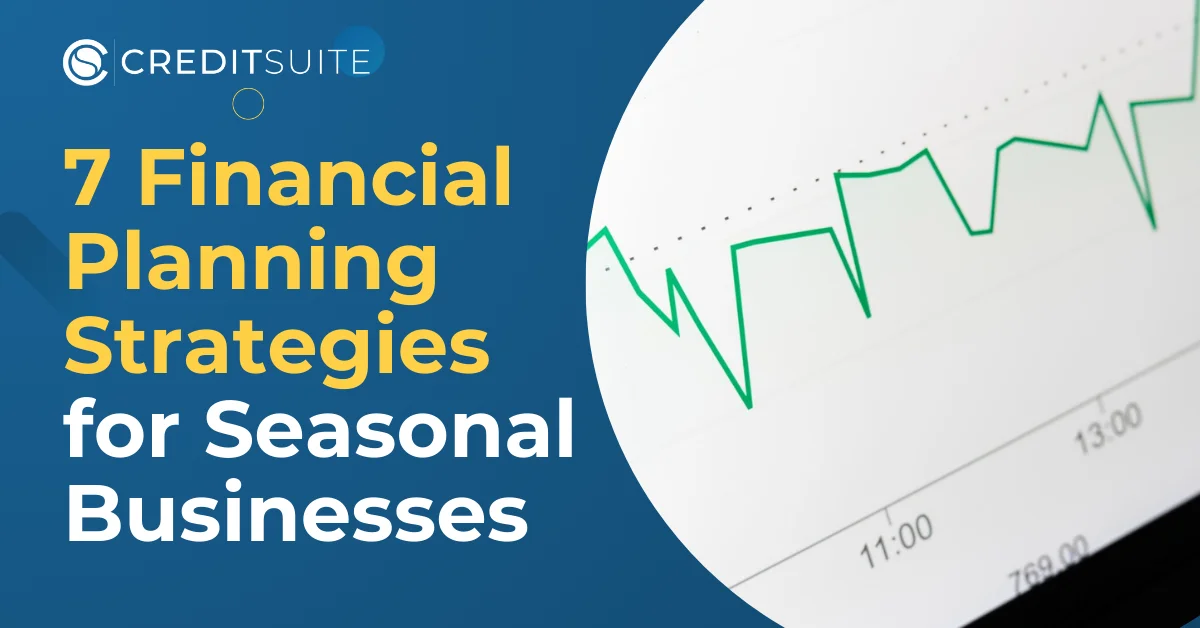Advanced Financial Planning for Seasonal Businesses: Navigating the Peaks and Valleys
How does the behavior of professional athletes during their off-season impact their performance in peak season, especially if they choose to indulge in partying, consume unhealthy food, and skip those intense gym sessions?
Athletes who diligently enhance their skills when not competing often excel in their regular season (think of some of the greats like Serena Williams or Michael Phelps).
Well, this principle also applies to seasonal business owners. It’s essential to understand that smart financial planning in slower periods is crucial for maximizing results in busier times.
In this article, we’ll dive into seven financial tactics that can support your business during its slower phases and set it up for remarkable success when the situation improves.
What is a seasonal business?
Seasonal industries typically experience a high demand for their products or services during certain months or quarters, often referred to as the peak season.
However, demand can drop significantly outside this period, sometimes to almost nothing. This business pattern can be quite a challenge, especially when maintaining a steady cash flow throughout the year.
Revenue can vary greatly, with busy times bringing in floods of sales and quieter periods seeing much less. This earnings rollercoaster can make it tough for businesses to cover their day-to-day expenses. It also prevents them from investing in opportunities to grow.
A 2022 study by Skynova points out that 44% of businesses fail because they run out of cash. That statistic looks even scarier for those running a seasonal business.
So, as a seasonal business owner, you must be particularly savvy with your financial management to keep your business afloat all year round.
Take a pool company (no pun intended) or even a lemonade stand, for example. They rake in most of their profits during the sunny summer months when customers crave a way to cool off.
But once the weather cools down (and business slows), they’ll need to be really smart about how they use their summer earnings. Careful budgeting is necessary to guarantee they can cover all their operational costs and other varying expenses during those quieter, colder months.
7 Strategies for navigating peaks and valleys for seasonal businesses
Proper cash preservation strategies allow you to run a profitable seasonal business despite the inherent cash flow fluctuations.
Ready to learn more? Here are seven simple strategies for navigating the peaks and valleys of all seasonal business experiences.
1. Employ strategic cash flow management
Strategic cash flow management for seasonal businesses hinges on two pivotal pillars: forecasting and budgeting.
These dynamic tools empower business owners to navigate demand and revenue fluctuations deftly.
That said, it’s important to leverage your business’s historical data and market business trends to calculate cash flow projections to guide your spending decisions.
A cash flow statement will provide not just a snapshot of your cash inflow but also your cash outflow. Use this financial statement to develop a contingency plan to help your business navigate the turbulent waters of entrepreneurship.
A best practice during downtime is to create a 13-week cash flow model and adjust it weekly for quick pivots.
When combined with forecasting, budgets are your sure guide through these murky waters, as they’ll help you exercise significant control over expenses and establish firm financial goals.
2. Diversify your offerings
With a little creativity, you can diversify your customer base or offerings to build additional revenue streams that’ll reduce your reliance on specific seasons.
Start small by diversifying your product offering.
Take the example of a Christmas tree farm based in North Carolina. Outside the holiday season, they could diversify by offering other trees and plants in the spring and summer. Or maybe planting a pumpkin patch to engage customers in the fall.
The possibilities for creativity are endless. It’s all about looking at what you’re already good at and figuring out how to use your existing skills, space, and gear to make some extra cash.
Another smart move is geographic diversification. If your business does well in one area during its busy season, why not think about spreading out to other places that have different peak times? This way, you can keep the cash flowing all year.
Teaming up with other businesses is another great strategy. For instance, an ice cream shop could partner with a coffee shop. Together, they could whip up some unique drinks for the colder months. It’s a cool way to keep customers coming through the door, even when most people think it’s too chilly for ice cream.
3. Minimize expenses during slow seasons
For seasonal businesses, you must cut costs during periods of low cash flow. It’s the only way to ensure financial stability. It’s not easy, but it’s necessary.
Here are a few simple ways you can save money:
- Adopt just-in-time inventory management to prevent overstocking and free up cash
- Renegotiate your supplier contracts
- Temporarily downsize your staff
4. Maximize revenues during peak customer demand
On the flip side, it’s always wise to strike when the iron is hot.
In other words, when demand for your products or services is high, try to find ways to maximize your revenue streams. Forecasting demand can help you achieve this. Then it’s a matter of maintaining enough inventory to meet your customers’ demands.
Peak seasons are the best time to increase your marketing campaigns and promotional strategies. Double down on what works and experiment with new strategies, such as:
- Investing in influencer marketing
- Creating social media content
- Running social media ads
- Paying for billboards
- Sharing flyers
According to Statista, in 2023, 58% of shoppers in the United States said they had purchased a product after seeing it on social media.
Create promotional offers such as buy one, get one free, or offer free shipping. After all, according to a 2022 study by Ipsos and Octopia, 85% of consumers won’t shop from you again after one poor delivery experience.
Promote customer satisfaction and increase retention by collaborating with efficient courier services to streamline operational processes and ensure timely deliveries.
Create frequent-shopper programs where they can rack up points, VIP programs, and other membership forms to encourage repeat customers.
Pro tip: Need more inspiration on how to maximize revenue streams? Look at what your competitors are doing. Use advanced competitor analysis tools to gain insights into your competitors’ strategies and adjust your own strategy to beat them.
5. Maintain strong cash reserves
The best way to protect yourself and your business against an industry downturn is to hold enough cash in reserve to cover at least 27 days of everyday expenses.
During the off-peak season, when revenues are low, those reserves act as a financial safety net to prevent disruptions in operations.
This cushion also allows you to seize growth opportunities, invest in marketing efforts before the seasonal period, and negotiate better terms with suppliers.
A best practice to automatically increase your cash reserves is depositing your balance into an online savings account, where you can safeguard your cash while earning higher interest rates than a standard business checking account.
Every penny counts. And a high-yield savings account works wonders to grow your reserves on autopilot.
6. Build a strong company culture
Retaining your workforce as a seasonal business can be challenging. When reducing staff to minimize expenses, consider keeping a few inspiring staff who are flexible and understand your business’s core values.
Hire part-time or seasonal workers during peak seasons to boost your workforce. You can also use freelancers or independent contractors to help run certain aspects of your business, such as marketing and social media management.
It’s important to treat staff who go through these slow and busy seasons with you like rock stars. Provide perks and incentives such as company swag, stipends, and bonuses.
Holger Sindbaek, the owner of World of Card Games, shares, “In my journey as an entrepreneur, I’ve learned that the foundation of any successful business, especially those facing seasonal fluctuations, lies in its culture. We focused on cultivating a culture where every team member felt invested in our vision, regardless of the season. This culture became our strength during quieter periods, allowing us to innovate and prepare for the busier times ahead. We encouraged cross-departmental collaborations and skill-sharing sessions, which kept our team engaged and sparked new ideas crucial for peak seasons.”
When your seasonal workers come in, show them you appreciate them. A good way to do this is by giving them customized gifts and perks like a team lunch or employee discounts.
7. Invest in customer relationships during off-peak and peak seasons
Repeat customers spend 300 times more than new customers. They also have a higher average order value than first-time consumers.
In other words, investing in initiatives that help you build a loyal customer base is well worth it.
Using a proposal software for new and prospective customers can be a great way to improve customer retention.
Start by consistently communicating with your customers through email marketing and social media. Remember, strike the right balance of helpful and informative without being annoying.
You can also attend community events to stay in sight and engage emotionally, ensuring customer retention and increased demand during peak periods.
For instance, you can sponsor kids’ sports, the local library, fun runs, and more. Community engagement keeps your name in mind and brings emotional engagement that can help ensure customer retention and improve future demand.
Slow times are inevitable — navigating them with wisdom is what matters
Understanding that slow times are part of the journey is the first step to navigating them.
The key lies in leveraging these moments wisely. Use them as opportunities to refine and fortify the business for the inevitable return of prosperous seasons.
Approach each phase with resilience, adaptability, and strategic foresight. With this approach, you can weather the slow times and position yourself for unparalleled success.


